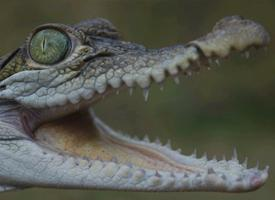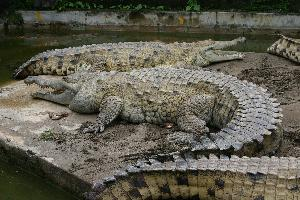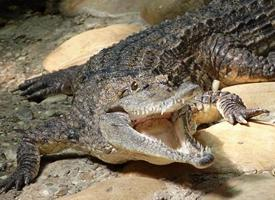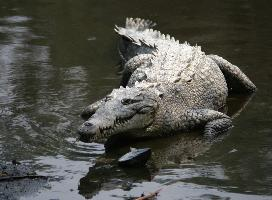
Weights and measures
| Length | 5 m |
|---|---|
| Weight | from 180 to 450 kg |
State of endangerment
| Endangered |
Animal description
The American crocodile (Crocodylus acutus) is a fascinating and formidable reptile that inhabits the warmer waters and coastal areas of the Americas. Characterized by its distinctive appearance and behavior, this species plays a crucial role in the ecosystem, acting as both predator and indicator of ecological health. The American crocodile is a testament to the adaptability and resilience of crocodilians, having survived millions of years with minimal evolutionary changes.Physical Characteristics
The American crocodile is a large and imposing reptile, with adult males reaching lengths of up to 20 feet (about 6 meters), although sizes closer to 11 feet (about 3.5 meters) are more common. Females are generally smaller than males. This species has a more V-shaped snout compared to the U-shaped snout of alligators, which allows for a distinction between the two. Their skin is a rugged, olive-brown color, providing camouflage among the mangroves, riverbanks, and coastal estuaries they inhabit. Their belly is a paler, almost yellowish-white, providing a stark contrast to their darker dorsal side.
The American crocodile's body is designed for an aquatic lifestyle. Its eyes, ears, and nostrils are located on top of its head, allowing it to see, hear, and breathe while the rest of its body is submerged. The tail is muscular and powerful, propelling the crocodile through water with ease. Their feet are partially webbed, aiding in swimming but also making them surprisingly agile on land over short distances.
Habitat and Distribution
The American crocodile is found in various parts of the Caribbean, Central America, South America, and the southern tip of Florida in the United States. They prefer brackish or saltwater environments, making their homes in mangroves, estuaries, coastal lagoons, and even small islands. Their habitat choice reflects their tolerance for saltwater, a trait that distinguishes them from many other crocodilian species.
Diet and Hunting Behavior
As apex predators, American crocodiles play a vital role in their ecosystem, helping to maintain the balance of animal populations. Their diet is diverse, feeding on fish, birds, mammals, and occasionally carrion. They are known for their "sit-and-wait" hunting strategy, where they remain almost completely submerged and motionless in the water, waiting for unsuspecting prey to come close. They then launch a swift and powerful attack, using their strong jaws to capture and drown their prey.
Reproduction and Lifecycle
American crocodiles are solitary animals for most of the year, coming together only during the breeding season. Females lay eggs in nests made of vegetation, which they fiercely protect until the eggs hatch. The temperature of the nest determines the sex of the offspring, a phenomenon known as temperature-dependent sex determination. Once hatched, the young crocodiles are vulnerable to predators, including birds and mammals. The mother may guard her young for a few weeks to several months, but eventually, they disperse to lead solitary lives.
Conservation Status
The American crocodile is listed as Vulnerable on the IUCN Red List, with habitat destruction, illegal hunting, and human encroachment posing significant threats to their populations. Conservation efforts are underway in many parts of their range, aiming to protect habitats and reduce human-crocodile conflicts. Education and research are critical components of these conservation strategies, helping to ensure that these ancient reptiles continue to thrive in their natural environments.
In conclusion, the American crocodile (Crocodylus acutus) is a remarkable creature, embodying the resilience and complexity of the natural world. Despite facing numerous challenges, their continued presence in the Americas is a testament to the effectiveness of ongoing conservation efforts and the importance of preserving our planet's biodiversity.
Map of occurrence
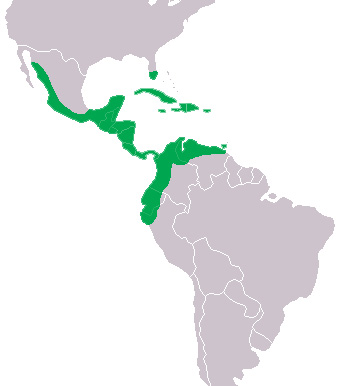
Similar Animals
New photos of animals
Top 10 animals
- Dolphin gull (Leucophaeus scoresbii)
- Diana monkey (Cercopithecus diana)
- Moustached guenon (Cercopithecus cephus)
- Galápagos tortoise (Geochelone nigra complex)
- Japanese macaque (Macaca fuscata)
- Stone loach (Barbatula barbatula)
- Russian tortoise (Testudo horsfieldii)
- Greek tortoise (Testudo graeca)
- Common flying dragon (Draco volans)
- Vendace (Coregonus albula)
